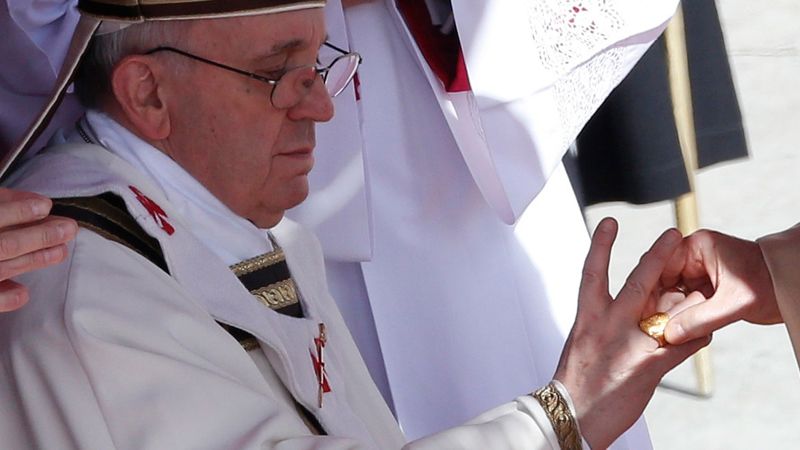Pope Francis' Fisherman's Ring: Why Destruction is a Sacred Tradition
Editor’s Note: News has broken regarding the destruction of Pope Francis' Fisherman's Ring following his death. This article explores the historical and symbolic reasons behind this unique tradition.
Why This Matters: Understanding the Significance of the Fisherman's Ring
The destruction of Pope Francis' Fisherman's Ring isn't merely a symbolic gesture; it's a deeply rooted tradition with significant implications for the Catholic Church and its followers. This act underscores the transient nature of earthly power and the enduring authority of the papacy itself. The ring, a powerful symbol of papal authority, is destroyed to prevent its potential misuse or the forging of fraudulent documents. Understanding this tradition offers insight into the Catholic Church's history, its views on power, and its commitment to maintaining the integrity of its leadership. This article delves into the key aspects surrounding this significant event, exploring its historical context, theological significance, and practical implications.
Key Takeaways
| Point | Explanation |
|---|---|
| Tradition of Destruction | A long-standing practice ensuring no misuse of papal authority after a Pope's death. |
| Symbolism of Mortality | Underscores the transient nature of earthly power and the enduring faith. |
| Preventing Forgery | Protects against the creation of fraudulent papal documents. |
| Ceremony & Significance | A ritualistic act carrying deep religious and historical meaning. |
Pope Francis' Fisherman's Ring: A Symbol of Papal Authority
The Fisherman's Ring, or Anulus Piscatorius, is far more than just jewelry; it's a potent emblem of the Pope's authority and a centuries-old tradition. Its design, typically depicting Saint Peter casting a net, symbolizes the Pope's role as the successor of Saint Peter and the "fisher of men." This ring has been used to seal papal documents for centuries, adding a layer of authenticity and authority to official communications. The destruction of the ring after a Pope's death is not a recent development; it's a practice dating back hundreds of years, highlighting its significance within the Catholic Church.
Key Aspects of the Fisherman's Ring Tradition
- Historical Context: The tradition likely originated as a way to prevent forged documents from being issued in the Pope's name after his death. In a time before sophisticated methods of verification, destroying the ring was a practical measure to safeguard against potential fraud.
- Theological Significance: The destruction of the ring symbolizes the transience of earthly power and the enduring nature of the spiritual authority vested in the papacy itself. It serves as a reminder that even the highest earthly office is temporary, and that true authority resides in God.
- Ceremony and Ritual: The destruction of the ring is often a private ceremony, highlighting its sacred nature and solemn significance. It represents the closing of one papacy and the commencement of another.
The Destruction Ceremony: A Sacred Ritual
The ceremony surrounding the destruction of the Fisherman's Ring is typically a private affair, emphasizing its profound religious significance. It's not a public spectacle but a solemn ritual that marks the end of one papacy and the beginning of another. The precise details may vary, but the core act – the destruction of the ring – remains consistent. This act, while seemingly simple, reinforces the deep-seated beliefs and traditions of the Catholic Church.
People Also Ask (NLP-Friendly Answers)
Q1: What is the Fisherman's Ring?
A: The Fisherman's Ring, or Anulus Piscatorius, is a ring worn by the Pope, symbolizing his authority as the successor of Saint Peter and the "fisher of men."
Q2: Why is the Fisherman's Ring destroyed after a Pope's death?
A: The ring's destruction prevents the forging of papal documents and symbolizes the transient nature of earthly power.
Q3: How does the destruction of the ring benefit the Catholic Church?
A: It safeguards against fraudulent documents and reinforces the Church's commitment to upholding its integrity and authority.
Q4: What are the main challenges associated with the tradition?
A: Maintaining the security and proper handling of the ring until its destruction are key logistical challenges.
Q5: What happens after the Fisherman's Ring is destroyed?
A: A new Fisherman's Ring is created for the newly elected Pope, continuing the tradition.
Practical Tips for Understanding Papal Symbolism
- Research Papal History: Explore the history of the papacy to understand the context of the Fisherman's Ring.
- Study Catholic Symbolism: Learn about the significance of symbols within the Catholic faith.
- Read Papal Encyclicals: Engage with the Pope's writings to grasp his theological perspectives.
- Follow Church News: Stay informed about events and changes within the Catholic Church.
- Discuss with Experts: Engage in conversations with theologians or Church historians for further insight.
- Visit Vatican City (if possible): Witness the grandeur and symbolism firsthand.
Summary: The destruction of Pope Francis' Fisherman's Ring is not simply a symbolic act; it's a deeply rooted tradition that reinforces the Church's commitment to integrity, transparency, and the ephemeral nature of earthly power.
Closing Message: The passing of a Pope, and the subsequent destruction of his ring, prompts reflection on the continuity of faith and the ever-present balance between earthly and spiritual authority. What does this tradition reveal about our understanding of power and legacy?
Call to Action: Share this insightful article with others interested in learning more about the Catholic Church's traditions and symbolism. Subscribe to our newsletter for more updates on religious news and analysis.

